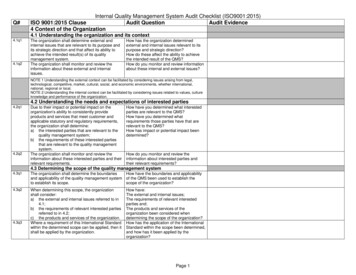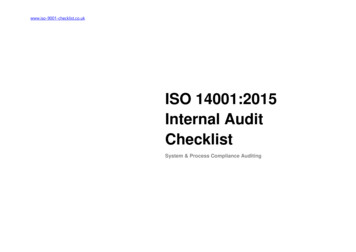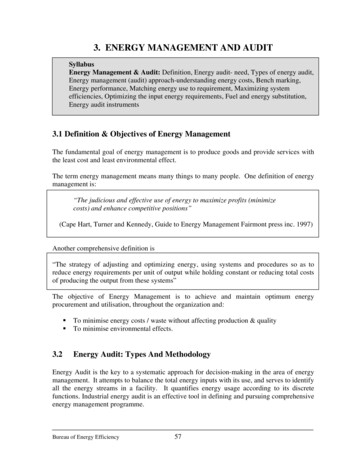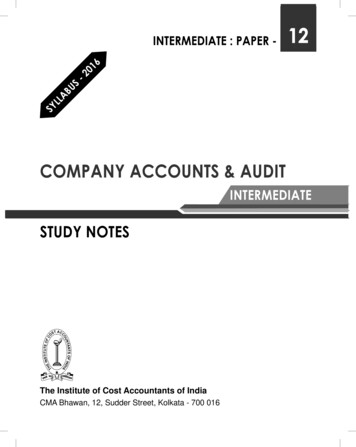
Transcription
“Audit Checklist and Methods: Ecological and Social Compliance”.22 May 2015Mumbai,India
TOPICS How an audit checklist is prepared and methods of auditing? How has auditing developed throughout the years? What opportunities and challenges does auditing face? Auditing: what has to change? Ecological and social auditing
Benefits of auditing & Auditing Checklist Adds value to products Consumer trust – recognition Validation and Assurance of sustainabilityclaims on product (organic, recycled,sustainable) Auditing checklist- Standard reference Vs ChecklistInterpretations for questions askedDocuments concerned for verificationTesting- Physical, chemical, biological & socialGuidelinesTraining on checklistEvaluation procedures/ criteriasQyality and Programme manual
Methods of auditing Methods depend upon time and type of auditing Announced Vs Unannounced audit Incidence audit (Audit due to calamity/ accidents/happenings) Addition and deletion of units- linked audit Standard version change audit Desktop auditBasic Skeleton:1. Pre-audit documents2. Inspector documents3. Opening and closing meeting4. Scopes audit onsite & Documents audit- Inputs,labeling, linked source documents)1. Checklist and Standard reference for checklist2. Non conformity and Observations
Textile Certification ProgramsAgricultureProcessed Product
RetailerStandardOwnerCertificationBodySupply ChainCotton FarmCollectorProcessingRetailer/Brands
Textile ProcessProcessorNatural ingknitting millweaving milldyeing millfinishingend product
Basic FeaturesOrganic FibresEnvironmental and Social CriteriaConcerns allProcessing StagesTesting for Harmful SubstancesGOTS slide 8 05/06/2015
Unified Certificate Templates
Basic Key criteria for fiber useOrganic Fibers, Composition andLabeling GuidelinesGOTS slide 10 05/06/2015
CriteriaOrganic FibresFibres AllowedItemFibres Not AllowedGMO Fibres & AsbestosNatural Fibres like Cotton, Bast, Silk,Wool, Other Animal Fibres (CertifiedOrganic & Inconversion)Fibres RestrictedSynthetic & Regenerated (Max10%)Special Conditions (Restricted For socks, & Sportswear etc.fibres)(Max 25%)GOTS slide 11 05/06/2015
Criteria for processing General criteria for all processing stages(e.g. separation, record keeping, environmental policy, social criteria) General ban on harmful substances in all processing stages(e.g. formaldehyde, toxic heavy metals, GMOs) General criteria for the assessment of chemical inputs(meeting limits on human and environmental (aquatic, fauna, flora and soil) toxicity as well as on biodegradability / -eliminability) Specific criteria for the different processing stages (e.g. functional waste water treatment plant for wet processing plants, limitations on materials for accessories and finishing methods)GOTS slide 12 05/06/2015
Processing Stages Chemicals/ enzymes used atvarious stages Inputs should conform toGOTS Version 4.0 Positive lists available withCB’s. Social and EnvironmentcriteriaGOTS slide 13 05/06/2015
Minimum Social Criteria Meeting social minimum criteria based on the ILO key norms is compulsory for all processing and manufacturing stages.The requirements include e.g.: No child labor Payment of living wages Working hours must not be excessive Safe and hygienic working conditions No discrimination, no harsh or inhumane treatment Operators must establish social compliance management tools that support the implementation and monitoring of the social minimumCriteria along with local legislation.GOTS slide 14 05/06/2015
Environment Criteria Energy & Water Consumption Data Waste & Discharges Chemical & Sludge DisposalTesting Criteria for Discharged water:Local LegislationsGOTS slide 15 05/06/2015
Storage, Packing and Transport Contamination with non organic products is prohibited PVC in packing materials is prohibited Pesticide/ Biocide use in storeroom/ transportation has to be in accordance with International/ National Organic ProductionStandardGOTS slide 16 05/06/2015
Dual system for quality assurance CertificationOn-site inspection of the entire processing chain up to the import levelAnnual inspection cycleOrganic product flow, environmental and social criteriasubject to inspection & GOTS slide 17 05/06/2015Residue TestingOrientation values for residuesRisk assessment of contaminationAnalysis in ISO 17025 accredited labs
An auditor’s daily work
Natural fibers that are;Certified organic or in-conversion organicfibersInternational or national organicfarming standard e.g. EU, NOP, NPOPetc.Certification /accreditation IFOAM orinternationally recognized standard(ISO 65 or EN45011 )
Reception check d keeping
Processing:Clean machines, containers store areas before start organic process
Separation of organic productsAll stages through the processing chain ensure that organic and conventional fibersare not commingled organic fibers are not contaminated bycontact with prohibited substances. All organic raw materials must be clearly labeled and identified as such at all stages through the processing chain
SeparationMeaning of separation?Contamination prevention between organic /non-organic products as well asther prohibited substancesIs it here?o
Output StorageFinish products should be packed, labeled and sealed properly.
Lack of details in the label
TransportationTransport certified claimed products with proper labels &accompanying transport documentsTRANSACTION CERTIFICATE (TC) FOR TEXTILE PROCESSED ACCORDING TO THE GLOBAL ORGANIC TEXTILESTANDARD (GOTS)1. Body issuing the certificate (name and address)2a) Licensing code of the certification body GOTS-CUC-03Control Union certifications B.V.Meeuwenlaan 4-68011 BZ ZWOLLENETHERLANDS3. Seller of the product (name and address)4. Inspection body* (name and address)2b) Reference number of the certificate: PRJ 816471/252974CIS Test CompanyMeeuwenlaan 4-68011 BZ ZwolleOverijsselNETHERLANDSControl Union certifications B.V.Meeuwenlaan 4-68011 BZ ZWOLLENETHERLANDS5. Last processor of the product(s) (name and address)6. Country of dispatchNETHERLANDSCIS Test CompanyMeeuwenlaan 4-68011 BZ ZwolleOverijsselNETHERLANDS7. Buyer of the product(s) (name and address)AAA Organic Pvt. Ltd.Brijdham Complex, 255, Canal Street, Bld.6, Flat 4, Shreebhumi, VIPRoad700048 KolkataWest BengalINDIA8. Consignee of the product (Address of the place of destination)H & M Hennes & MauritzSisli Ayazaga Buyukdere Cad 3 Yol Mevkii Noramin Is Merkezi No:55 Kat: 2 D: 206Maslak34398 IstanbulTURKEY9. Country of consigneeTURKEY10. Product and shipment information11. Gross weight(kg)Global Organic Textile Standard (GOTS-NL) certified1200.00 kgsProducts as specified in box: 17from organic production methods.Invoice no.: inv 0111 d.d. 01-09-12Transport document no.: trns 0022 d.d. 01-09-12Container no.: 123U456789-012. Net weight(kg)1000.00 kgs13. Commercial weight (kg)Identification codes : Org GOTS Test 010.00 kgs14. Declaration of the body issuing the certificateThis is to certify that the organic fibre material(s) specified in box 17 used for the products designated above has been produced in accordance with (an) organic farmingstandard(s) which is/are recognised by the Global Organic Textile Standard (GOTS) and that the products have been processed in accordance with GOTS. Compliance withthis standard is continually monitored by the inspection body named in box 4.15. Additional declarationCertification of the organic fibres used for the products listed complies with USDA NOP rules :Yes No(relevant information for products marketed and sold in the US; obligatory information for any GOTS TC)Organi cotton fiber certified as per NPOPThe raw material (fibre) used for the products designated above has been produced in accordance with the USDA NOP standards16. Place and date of issue Colombo-07, 07 September 2012Name and signature of authorised personOn behalf of Managing DirectorStamp of the issuing bodyCOPYNabadawewa, Mr. M. C. K. (Mahesh)1 of 2
Traceabilityany processing stage to the origin of certified fiberCompliance
Traceability via documentationTracing back any processing stage to the origin via lot numbers ondocumentation and record keeping.All the chemical consumption and stock records
Chemical Use Must use approved Chemicals by ancertification body accredited by GOTS. Store properly to avoid contamination Assurance of correct recipe and ratio Record keeping of receipt and issuance. Textile processing unit which doesn’thave chemical manufacturingprocess cannot obtain the approvalalone.
Accessory use Allowances Prohibitions Restrictionswhen using accessoriesRequires proof of ; labels MSDS Test reports Supplier’s material specification sheets*No separate approval program
Environmental criteriaAll operators must have an environmental policy including target goals procedures to minimize waste and dischargesThe waste water from all wet processing units must betreated in a functional waste water treatment plantWet processing units must keep full records of the use of chemicals, energy water consumption waste water treatment disposal of sludge.
Correct Chemical HandlingProper Chemical StoragePPEInstructions of chemicalhandlingAccess Control to GOTS chemicalsControl issue of chemicals
Incorrect Waste Disposal and Chemical Handling
QUALIFIEDRegular Audit (onsite/desk)Incidence AuditTRAININGSurprise/ Unannounced Audit
How has auditing developed throughout the years?
International Working GroupVoluntary organizationGovernmentPrivate organization/ Advisory Boards/ ExpertsISO GuidelinesVarious ReferenceGuidance DocumentsPreparation of standardsPolicy and procedureManual for implementationLabeling guidelines
Technical MaterialComposition Packaging Input evaluation Quality Control Quantity Control Record Keeping Internal Inspection Technical riskassessment(Physical, Chemical,Biological)Social ILO Country Regulation(both production &import regulation) State Legislation Local legislation Social riskassessmentEnvironmental Policy statementWaste DisposalEnergy ConservationWater ConservationDischarge pointQuality evaluationEnvironmental riskassessment
Onsite Audit vs Desk AuditPre-audit Project (process,scope) Quality management Programmemanagement withstandard Site to be audited(area assessment onthe basis of risks)AuditPost Audit Follow the policy ofthe company ifsuitable Review theinformation (opening,closing) Cover the check list Collect the evidence,incidence and sample Follow safetyguidelines Conduct Interviews Follow the audit planand timeline Report the facts Complete theassessment Raise the nonconformities if any Report to team Report to yourcertifier Send the sample andreport by mail/courier Follow up Nonconformity
What opportunities and challenges does auditing face?
Opportunities and Challenges
Bribes/ GiftsConsciousness & Knowledge
Version 1.0 2005 Basic regulations Inputs (restricted/ prohibited)Version 2.0 2008 More focused on chemicals/ accessories Fibre specifiedVersion 3.0 2011 Assessment criteria All process specified, packaging focusedVersion 4.0 2014, March 1st Fibre, chemicals, accessories more redefined GMO and analysis instructions will be enhanced
Auditing: what has to change?
What kind of improvementdoes the factory obtain rkersconfidenceAll raw materials are screenedFibres, social & environmentare well addressedTime, space, peoplemanagement with ALEconomicallyviable
Public Data BaseYou can search for GOTS certified entities, their fields of operation and certified products according to individual tabase.htmlGOTS slide 46 05/06/2015
Further Information www.global-standard.org GOTS and related documents available for download Public data base containing the GOTS certified entities, their products and fieldsof operation News and latest developments, subscribe to our newsletter. www.cottonedon.org https://www.facebook.com/sumit.gupta.3517GOTS slide 47 05/06/2015
Questions ?Interested to learn more ?Dr Binay Kumar ion.in 91-9969002860 91-9930453755Disclaimer:This presentation is for internal use only and can only be distributed with the consent of the original author
Announced Vs Unannounced audit Incidence audit (Audit due to calamity/ accidents /happenings) Addition and deletion of units- linked audit Standard version change audit Desktop audit Basic Skeleton: 1. Pre-audit documents 2. Inspector documents 3. Opening and closing meeting 4. Scopes audit onsite & Documents audit- Inputs,










